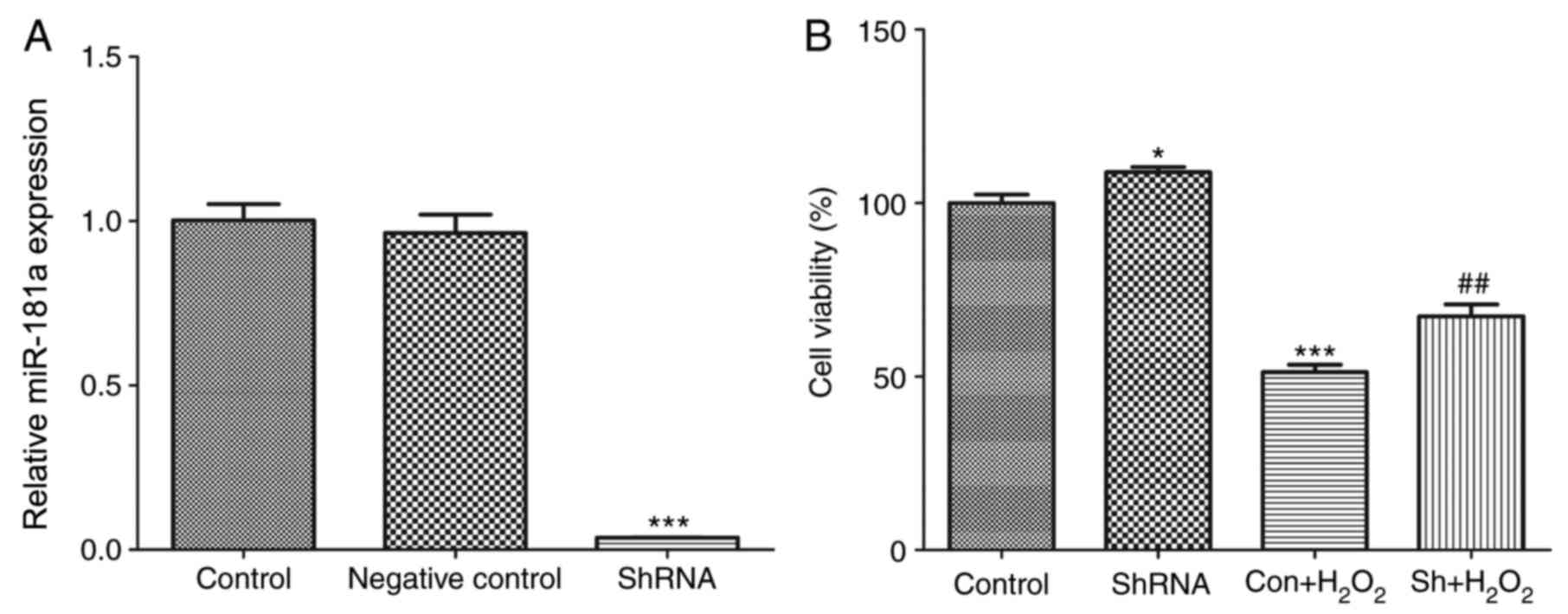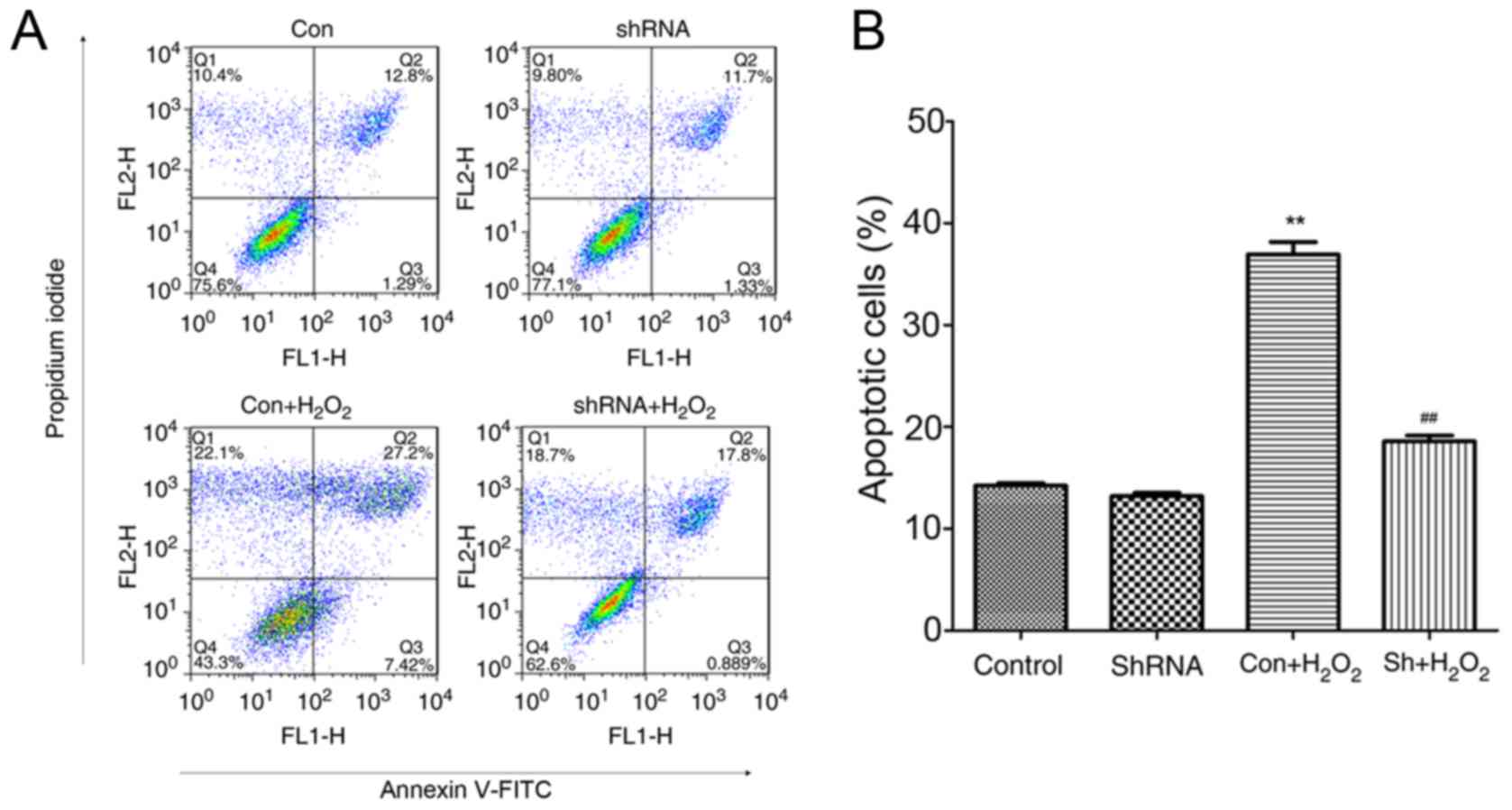|
1
|
Asbell PA, Dualan I, Mindel J, Brocks D,
Ahmad M and Epstein S: Age-related cataract. Lancet. 365:599–609.
2005. View Article : Google Scholar : PubMed/NCBI
|
|
2
|
Hoffmann A, Huang Y, Suetsugu-Maki R,
Ringelber CS, Tomlinson CR, Del Rio-Tsonis K and Tsonis PA:
Implication of the miR-184 and miR-204 competitive RNA network in
control of mouse secondary cataract. Mol Med. 18:528–538. 2012.
View Article : Google Scholar : PubMed/NCBI
|
|
3
|
Khee SG, Yusof YA and Makpol S: Expression
of senescence-associated microRNAs and target genes in cellular
aging and modulation by tocotrienol-rich fraction. Oxid Med Cell
Longev. 2014:7259292014.PubMed/NCBI
|
|
4
|
Chien KH, Chen SJ, Liu JH, Chang HM, Woung
LC, Liang CM, Chen JT, Lin TJ, Chiou SH and Peng CH: Correlation
between microRNA-34a levels and lens opacity severity in
age-related cataracts. Eye (Lond). 27:883–888. 2013. View Article : Google Scholar : PubMed/NCBI
|
|
5
|
Li WH, Kang ZF and Li L: Research of
controlling genes of lens epithelial cell apoptosis and cataract.
Int J Ophthalmol. 10:88–89. 2010.
|
|
6
|
Li Y, Liu S, Zhang F, Jiang P, Wu X and
Liang Y: Expression of the microRNAs hsa-miR-15a and hsa-miR-16-1
in lens epithelial cells of patients with age-related cataract. Int
J Clin Exp Med. 8:2405–2410. 2014.
|
|
7
|
Khan L, Khan RA, Ahmed W, Rauf A, Khan WM,
Khan W, Durrani SA and Qayum: Frequency, causes and cutting-edge
treatment of cataract: A review. American J Biomed Life Sci.
3:25–28. 2015. View Article : Google Scholar
|
|
8
|
Yang Y, Sharma R, Cheng JZ, Saini MK,
Ansari NH, Andley UP, Awasthi S and Awasthi YC: Protection of HLE
B-3 cells against hydrogen peroxide-and naphthalene-induced lipid
peroxidation and apoptosis by transfection with hGSTA1 and hGSTA2.
Invest Ophthalmol Vis Sci. 43:434–445. 2002.PubMed/NCBI
|
|
9
|
Bai J, Zheng Y, Dong L, Cai X, Wang G and
Liu P: Inhibition of p38 mitogen-activated protein kinase
phosphorylation decreases H2O2-induced
apoptosis in human lens epithelial cells. Graefes Arch Clin Exp
Ophthalmol. 253:1933–1940. 2015. View Article : Google Scholar : PubMed/NCBI
|
|
10
|
Tanaka Y, Tsuda S, Kunikata H, Sato J,
Kokubun T, Yasuda M, Nishiguchi KM, Inada T and Nakazawa T:
Profiles of extracellular miRNAs in the aqueous humor of glaucoma
patients assessed with a microarray system. Sci Rep. 4:50892014.
View Article : Google Scholar : PubMed/NCBI
|
|
11
|
Dong N, Xu B and Tang X: miRNA-181a
inhibits the proliferation, migration and epithelial-mesenchymal
transition of lens epithelial cells. Invest Ophthalmol Vis Sci.
56:993–1001. 2015. View Article : Google Scholar : PubMed/NCBI
|
|
12
|
Wu C, Lin H, Wang Q, Chen W, Luo H, Chen W
and Zhang H: Discrepant expression of microRNAs in transparent and
cataractous human lenses. Invest Ophthalmol Vis Sci. 53:3906–3912.
2012. View Article : Google Scholar : PubMed/NCBI
|
|
13
|
Peng CH, Liu JH, Woung LC, Lin TJ, Chiou
SH, Tseng PC, Du WY, Cheng CK, Hu CC, Chien KH and Chen SJ:
MicroRNAs and cataracts: Correlation among let-7 expression, age
and the severity of lens opacity. Br J Ophthalmol. 96:747–751.
2012. View Article : Google Scholar : PubMed/NCBI
|
|
14
|
Yu Q, Zhao J, Min X, Wang M, Luo W, Wu D,
Yan Q, Li J, Wu X and Zhang J: MicroRNA-125b inhibits lens
epithelial cell apoptosis by targeting p53 in age-related cataract.
Biochim Biophys Acta. 1842:2439–2447. 2014. View Article : Google Scholar : PubMed/NCBI
|
|
15
|
Dong Y, Zheng Y, Xiao J, Zhu C and Zhao M:
MicroRNA let-7b induces lens epithelial cell apoptosis by targeting
leucine-rich repeat containing G protein-coupled receptor 4 (Lgr4)
in age-related cataract. Exp Eye Res. 147:98–104. 2016. View Article : Google Scholar : PubMed/NCBI
|
|
16
|
Wang L, Huang H, Fan Y, Kong B, Hu H, Hu
K, Guo J, Mei Y and Liu WL: Effects of downregulation of
microRNA-181a on H2O2-induced H9c2 cell
apoptosis via the mitochondrial apoptotic pathway. Oxid Med Cell
Longev. 2014:9603622014. View Article : Google Scholar : PubMed/NCBI
|
|
17
|
Hu G and Luo J: A primer on using pooled
shRNA libraries for functional genomic screens. Acta Biochim
Biophys Sin (Shanghai). 44:103–112. 2012. View Article : Google Scholar : PubMed/NCBI
|
|
18
|
Hatakeyama H, Murata M, Sato Y, Takahashi
M, Minakawa N, Matsuda A and Harashima H: The systemic
administration of an anti-miRNA oligonucleotide encapsulated
pH-sensitive liposome results in reduced level of hepatic
microRNA-122 in mice. J Control Release. 173:43–50. 2014.
View Article : Google Scholar : PubMed/NCBI
|
|
19
|
Stewart SA, Dykxhoorn DM, Palliser D,
Mizuno H, Yu EY, An DS, Sabatini DM, Chen IS, Hahn WC, Sharp PA, et
al: Lentivirus-delivered stable gene silencing by RNAi in primary
cells. RNA. 9:493–501. 2003. View Article : Google Scholar : PubMed/NCBI
|
|
20
|
Zhang BG, Li JF, Yu BQ, Zhu ZG, Liu BY and
Yan M: microRNA-21 promotes tumor proliferation and invasion in
gastric cancer by targeting PTEN. Oncol Rep. 27:1019–1026. 2012.
View Article : Google Scholar : PubMed/NCBI
|
|
21
|
Schmittgen TD and Livak KJ: Analyzing
real-time PCR data by the comparative C(T) method. Nat Protoc.
3:1101–1108. 2008. View Article : Google Scholar : PubMed/NCBI
|
|
22
|
Wu H, Xing K and Lou MF: Glutaredoxin 2
prevents H2O2-induced cell apoptosis by
protecting complex I activity in the mitochondria. Biochim Biophys
Acta. 1797:1705–1715. 2010. View Article : Google Scholar : PubMed/NCBI
|
|
23
|
Huang CK, Lin Y, Su H and Ye D:
Forsythiaside protects against hydrogen peroxide-induced oxidative
stress and apoptosis in PC12 cell. Neurochem Res. 40:27–35. 2015.
View Article : Google Scholar : PubMed/NCBI
|
|
24
|
Bergamini CM, Gambetti S, Dondi A and
Cervellati C: Oxygen, reactive oxygen species and tissue damage.
Curr Pharm Des. 10:1611–1626. 2004. View Article : Google Scholar : PubMed/NCBI
|
|
25
|
Giorgio M, Trinei M, Migliaccio E and
Pelicci PG: Hydrogen peroxide: A metabolic by-product or a common
mediator of ageing signals? Nat Rev Mol Cell Biol. 8:722–728. 2007.
View Article : Google Scholar : PubMed/NCBI
|
|
26
|
Galluzzi L, López-Soto A, Kumar S and
Kroemer G: Caspases connect cell-death signaling to organismal
homeostasis. Immunity. 44:221–231. 2016. View Article : Google Scholar : PubMed/NCBI
|
|
27
|
Colin J, Garibal J, Clavier A, Szuplewski
S, Risler Y, Milet C, Gaumer S, Guénal I and Mignotte B: Screening
of suppressors of bax-induced cell death identifies
glycerophosphate oxidase-1 as a mediator of debcl-induced apoptosis
in drosophila. Genes Cancer. 6:241–253. 2015.PubMed/NCBI
|
|
28
|
Korhan P, Erdal E and Atabey N:
miR-181a-5p is downregulated in hepatocellular carcinoma and
suppresses motility, invasion and branching-morphogenesis by
directly targeting c-Met. Biochem Biophys Res Commun.
450:1304–1312. 2014. View Article : Google Scholar : PubMed/NCBI
|
|
29
|
He Q, Zhou X, Li S, Jin Y, Chen Z, Chen D,
Cai Y, Liu Z, Zhao T and Wang A: MicroRNA-181a suppresses salivary
adenoid cystic carcinoma metastasis by targeting the MAPK-Snai2
pathway. Biochim Biophys Acta. 1830:5258–5266. 2013. View Article : Google Scholar : PubMed/NCBI
|













